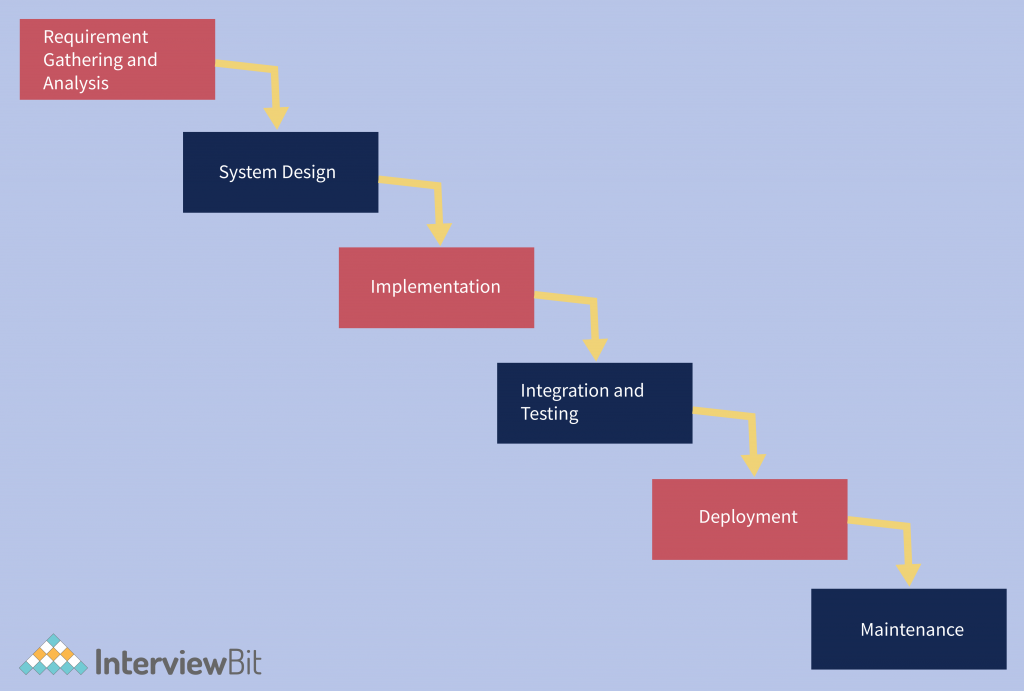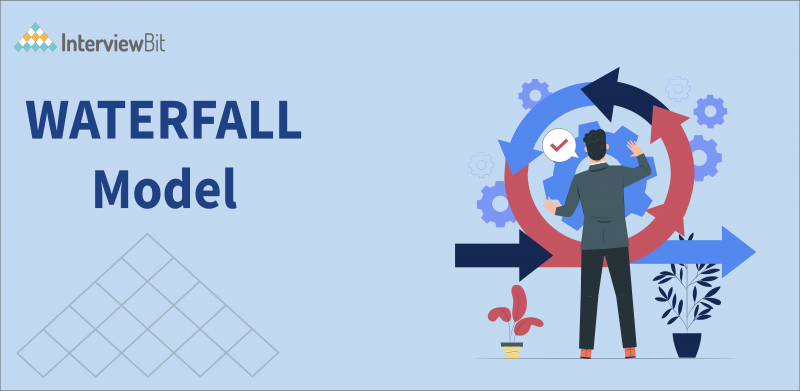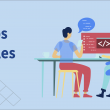Introduction
When working on a software project, team members must be clear about when and what to do. Otherwise, there would be chaos and project failure. A software life cycle model describes each phase entry and exit criteria.
A phase can only begin if its stage-entry criteria get fulfilled. It’s difficult for software project managers to keep track of its development without software life cycle models. To help them with this process, various models like the iterative model, spiral model, waterfall model, V model, and big bang model are defined as part of the SDLC process.
In this blog, you will come across the earliest approach introduced as a part of software development, named as Waterfall Model. You will learn how the Waterfall model works and then dive deeper into each of its phases. Additionally, you will get to know where this model lacks and where it fits better.
Confused about your next job?
What is Waterfall Model?
The waterfall model depicts the software development process in a linear sequential flow; due to this, it is also referred to as a linear-sequential life cycle model, which indicates that any development process steps can start only after the previous one has finished. The stages are always done in this order and never overlap. Before moving on to the next step, the developer must finish the present one. The model is called a waterfall because it progresses from one phase to the next logically.
There is an emphasis on the natural succession of these phases. During the SDLC phase, each step is meant to execute specific tasks.
This model can be used in the scenarios where,
- The requirements do not often change and the clients have a crystal clear understanding about what they want as the output from the software they wanted to be developed because there would be no scope of changing requirements in future.
- You are working on an application that is not complicated, for example, standalone applications which are short, like Customer Relationship Management (CRM) systems, Human Resource Management Systems (HRMS), Supply Chain Management Systems, etc.
- You have the clarity of the requirements provided by the clients, to achieve this step you may have query sessions with the users and can discuss the dos and dont’s of the software.
- The technology and tools used in the application are not dynamic.
Phases of Waterfall Model
Now you have got a brief idea of what the waterfall model is, let’s dive into the phases of this model that are followed sequentially. The diagram below shows you the steps that are involved in this model. You can easily depict that the waterfall model is a hierarchical paradigm that operates from top to bottom. One phase is completed with full verifications before moving on to the next.
Let’s understand this flow with the example of the request to create a new reservation system.

- Requirement Gathering and Analysis: This phase captures all feasible needs for the system to be created and documents them in a requirement specification document. The customer and software developer collaborate to document all software’s functionalities and performance. To further grasp the requirements, teams organize brainstorming sessions and get a clear walkthrough of the requirement. These requirements are then processed to perform a detailed analysis on how to proceed. The requirements are assessed for feasibility to ensure that they are testable. It also allows us to decide on the product’s hardware or software needs, the planning, developed, and captured along the process.
Example: Based on your analysis on the requirements provided by the client, you may ask questions like does the new reservation system support multiple languages? How many users are expected to be active on the application in one minute ? etc. - System Design: This is an important stage in the model. It’s in charge of analyzing the data you gathered in the first phase to be used in subsequent coding phases. It also aids in the overall architecture of the system design by providing a clear picture of the hardware and software needs. In this phase, the requirement specification is broadly researched and verified. It also aids in transforming the SRS document into the software product’s functional design and development. A Software Design Document is used to document all of this effort.
Example: The senior members of the team collaborate to discuss on high level design, low level design and system architecture of the software. This would include discussions on redundant backup and failover capabilities so that the system is accessible at all times. - Implementation: The output of the system design phase is fed into the implementation phase as part of the sequential flow. It is initially divided into small programs known as units used in subsequent testing and implementation phases. Unit testing is a technique that involves developing each unit in the implementation phase and then testing each module in isolation. Following that, these modules are tested by writing additional code to see how the modules interact with each other and with the flow of intermediate output. Because the SDD contains all of the information required by software developers, the implementation or coding phase goes smoothly if this document is complete.
Example: Based on the complexity of the application, the developer incorporate features like security checks, audit logging, etc for smooth functioning of the application. - Integration and Testing: This phase takes the designs and advancements from the previous processes as input. For various tests, they are integrated into a module or system. The testing environment is subjected to a continuous software check to see whether any flows or errors in the design or code exist. Alpha testing (done by the development team), beta testing (performed by a specified group of users), and acceptance testing (performed after delivery by the customers and decides for the acceptance or rejection of the software based on results and feedback) are all examples of system testing.
Example: For the project, testers with reservation domain knowledge were also employed so that they could test the application from a domain standpoint. The application’s security was put to the test by security testing teams. - Deployment of the system: After passing all of the tests, the software is installed on the user’s PC (released to the market). Installation, migration, and support of the entire system to the user or customer environment are part of the deployment process. This will make the customers happier, which will reduce maintenance costs, and results will be more accurate as a result of the improved output. The modules’ interactions with each other and the system are tested at this phase. While performing this step, you must ensure that the environment is up and running and check that the test exit conditions were fulfilled. It is also critical to perform sanity checks on the environment after the application has been deployed to ensure that it is functioning properly.
Example: To get the reservation system up and operating on the production servers, the teams requires to coordinate with network and IT administrative teams for smooth deployment process. - Maintenance: The core aspect of any product development cycle is providing support to your clients through good maintenance and regular checks. The waterfall model follows the same approach by having maintenance as the last phase. This process occurs shortly after installation and includes making the necessary modifications to the product or system and increasing, changing, or modifying aspects linked to system performance difficulties. In the client environment, some complications arise. Patches are published to address these vulnerabilities. To improve the product, newer versions of the product are produced.
Example: A reservation system consists of various sections that are responsible for performing separate functions like booking feature, payment feature, filtering feature, etc. And its important to keep these sections up to date because any failure in the live application can cause serious issues.
These issues that arise during the maintenance phase are mostly due to changes the customer or users want to make after the installation and testing phases are completed. Corrective maintenance (fixing issues that were not detected during the development phase), adaptive maintenance (executed when moving environments to improve system performance), and perfective maintenance (done on the requests of users which aim to enhance the software functionalities) are the three forms of maintenance.
Advantages of Waterfall Model
Now you have learned about the different phases of the Waterfall model, let’s move towards the pros of this model in the software development lifecycle.
- Because of the model’s rigidity, it’s simple to manage as you visit a single phase at once.
- There are specified deliverables and a review mechanism for each phase.
- The stages in the waterfall model are well defined.
- The waterfall paradigm works best for smaller projects with well-defined needs and there are high chances of risks and uncertainties due of complex nature of larger projects.
- One phase at a time is processed and completed.
- It solves a lot of problems since it goes through phases that are simple to understand and explain.
- Both the process and the outcomes are thoroughly recorded.
- Establishes a good habit: define before designing.
- A schedule can be created with deadlines for each stage of development, and a product can be guided through each phase of the development process model.
- It enables you to design before coding.
Disadvantages of Waterfall Model
The is always a scope of improvement in anything and so as this model. Due to its various disadvantages in specific scenarios, more improved models were introduced after it. Some of its disadvantages are listed below:
- There is a considerable risk and ambiguity in cases where the requirements get changed/modified in between the model implementation.
- Returning to the phase becomes extremely tough as the flow goes in a sequence without any interference.
- Not appropriate for projects with a moderate to high risk of change in requirements otherwise the results could get worse.
- The final product is being delivered late i.e after the flow of the waterfall model gets completed, since no prototype can be presented in the intermediate phases.
- The useful comments of the client cannot be incorporated into the continuing development phase.
- Because testing is done later, it is difficult to discover obstacles and hazards early in the process, making the chances of risk high as there could be chances of some discrepancies in the inytermediate stages which will affect the result of subsequent phases.
Conclusion
In this blog, you came across the various perspectives of the waterfall model. When compared to large projects, this approach is best suited for small software development projects since design, development, and implementation are easier in small projects. Under this model, all previous phases must be completed before moving on to the next, and this is why it is hardly preferable for big software development projects. Although most projects now use the Agile approach, the Waterfall technique is still helpful for smaller projects. The Waterfall model will produce the most significant outcomes if the requirements are testable and straightforward.
FAQs
What are the problems faced in the waterfall model?
This traditional model has various shortcomings. It cannot be totally implemented in real-world projects. The most important problem is you cannot switch to the next steps until you complete the previous one, so there could be no intermediate checks. You cannot accommodate changes easily. It also has no feedback path since there is no scope of error correction in between.
Why waterfall model is best?
As discussed earlier, the waterfall model has advantages in some scenarios, or it works best there. These scenarios could be when the requirements are well-defined and unchangeable, the technology is well-known and well-understood, the project isn’t long, and the risk is either nil or negligible.
It is best for these scenarios because it is straightforward to comprehend and apply. It’s simple to use. Tasks can be simply organized. Both the process and the outcomes are thoroughly recorded as a part of this model.
When is waterfall better than Agile?
Waterfall and Agile are two of the popular models defined in software engineering. Each of them has its advantages in specific scenarios, and if we talk about the Waterfall model, it is best suited to projects with clear deadlines and deliverables. The waterfall is generally the best strategy if your primary project limitations are fully understood and documented.
Can you mix Agile and Waterfall?
Yes, you can get the perfect blend of these two in the following scenarios:
On an enterprise level, use the Agile technique for requirements, design, and implementation while employing the Waterfall method for requirements, design, and performance.
At the project and company level, utilize the Waterfall technique, while for individual teams, use the Agile methodology.




